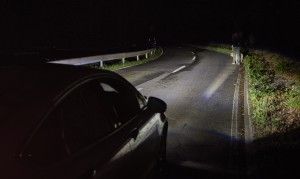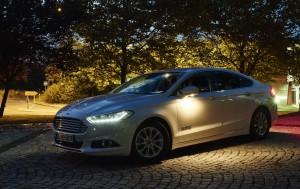
Ford is developing a new camera-based lighting system that allows the vehicle to adjust the brightness and direction of lights depending upon conditions.
Somewhere Preston Tucker is nodding his head in approval. The developer of perhaps the best-known vehicle using a moving headlight must be enjoying Ford Motor Co.’s development of adjustable lighting for its cars in Europe and Asia.
The automaker outlined its latest project, Camera-Based Advanced Front Lighting System, which uses GPS- and radar-enabled lighting to enhance a driver’s view of the road, ideally giving the motorist more time to react to changing road conditions or pedestrians or animals that may have strayed into the vehicle’s path.
The system widens the headlight’s beam at junctions and roundabouts to better illuminate hazards that are not in the direction of travel. Additionally, Spot Lighting technology helps draw the driver’s attention to pedestrians, cyclists and even large animals in the vehicle’s path or even just off the road.
“Many people who drive at night have had to quickly react to someone or something suddenly appearing in the road – as if from nowhere. Ford’s Camera-Based Advanced Front Lighting System and Spot Lighting help ensure the driver is quickly alerted to people or animals that could present a danger,” said Ken Washington, vice president, Ford Research and Advanced Engineering.
The system also uses GPS to locate areas where additional lighting could be helpful to a driver whether to see obstructions, signage, curves in the road, etc. It will also remember these locations and automatically adjust the lighting the next time the vehicle comes through that area.
It also uses radar mounted in the grill of the vehicle to detect objects on the road and quantify how dangerous they are to the vehicle depending upon distance away, speed of the vehicle and size of the object. Mercedes-Benz, Audi and other automakers have been using lighting systems that adjust to direction of a vehicle and other factors for some time now.
Since U.S. automotive lighting regulations restrict the use of additional lights, like the spot lights, Ford’s system isn’t going to show up on U.S. vehicles anytime soon. While the idea of changing the angles or directions of lights on vehicles to better improve visibility has been played up in recent years as a safety innovation, primarily on luxury vehicles, it’s not anything new.
(Ford pushes limits with new F-150 Limited. For more, Click Here.)
The earliest cars often had lights mounted in a manner that allowed them to turn in the same direction of the wheels. After all, where else do you need the light but in the direction you’re planning to go? Perhaps the most famous of the vehicles with this type of technology was the Tucker 48, also known as the Tucker Torpedo.
(Click Here for details about older airbags could be “hidden killers.”
Just after World War II, the aforementioned Preston Tucker produced a car featuring a third headlight mounted in the center of the hood that matched the steering angle of the front wheels to provide more visibility. At the time, more than a dozen states had rules against having more than two headlights so he simply produced a cover for the light to be used in those states.
(To see more of the new Infiniti Q30 “active compact,” Click Here.)
Ford’s systems are the “next steps” in the evolution of advanced lighting technology it already makes available, including:
- Dynamic LED Headlights which combines full-LED headlamps offering daylight-mimicking light clarity with Ford’s Adaptive Front Lighting System. The system adjusts the headlight beam angle and intensity to match the driving environment. It can choose one of seven settings according to vehicle speed, ambient light conditions, steering angle, distance to the vehicle in front and windscreen wiper activation
- Glare-Free Highbeam technology for the adaptive LED headlamps. The system detects vehicles ahead and fades out light that could dazzle oncoming drivers, while retaining maximum illumination for other areas
- Auto High Beam Control detects oncoming vehicles and automatically switches to dipped beam, before switching back to high beam once it detects the vehicle has passed


It sounds promising IF it can be made reliable. If not, then it’s an expensive lesson on what might possible.
This article cites Preston Tucker as an originator of the “steerable headlight” idea.
However, way back in the nineteen-twenties, “Pilot-Ray” headlights were aftermarket accessories in vogue among the owners of the finer automobiles. They were auxiliary headlights connected with the steering linkage, which swiveled as the front wheels were turned, lighting the way around turns.